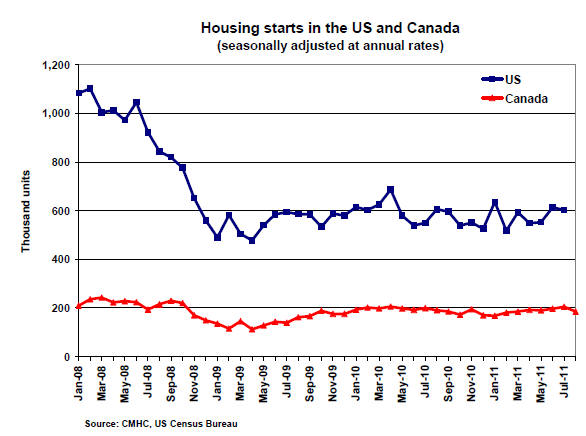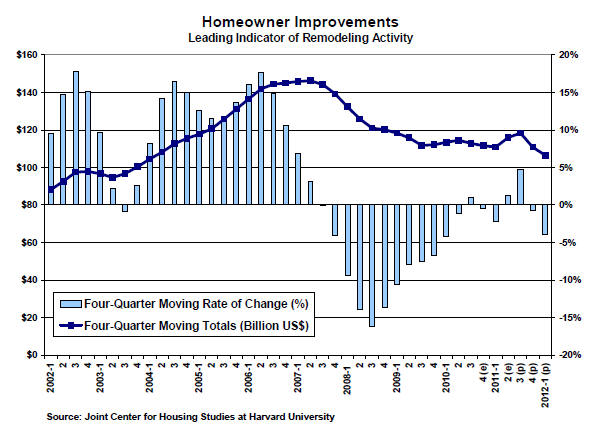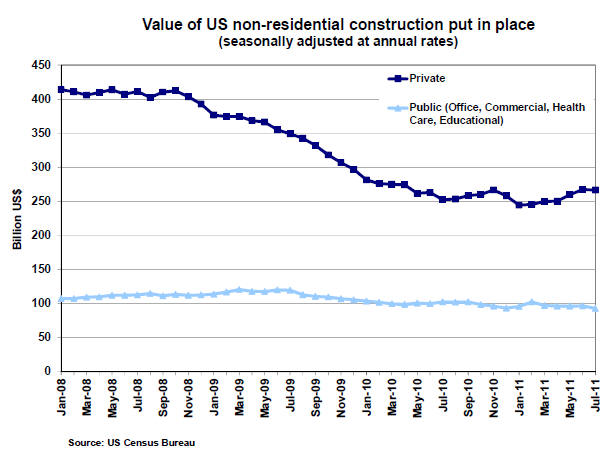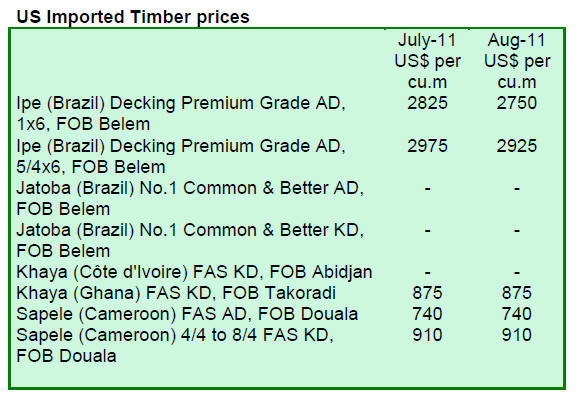|
Report
from
North America
OECD reduces US economic growth forecast
The recent fiscal debate in the US has negatively affected
consumer confidence and the confidence of the financial
markets in the government¡¯s ability to reduce federal debt
while improving the country¡¯s economy. The Organization
for Economic Cooperation and Development (OECD) has
revised the US growth forecast for this year from 2.6% to
1.4% in its latest world economic outlook.
To reduce unemployment and boost the economy,
President Obama unveiled a package of US$450 billion in
tax cuts and new spending. This includes social security
and payroll tax reductions if passed by the US Congress.
The package would be financed by reducing the federal
deficit and increasing taxes for the wealthy.
US Unemployment has not declined significantly since the
recession ended, and the August unemployment rate was
9.1%, unchanged from July, according to the US
Department of Labor.
The combined rate of unemployed and underemployed
Americans is estimated at 16% of the working-age
population. The usual rate of unemployment before the
recession was around 6%. Reducing unemployment is key
for the US economy where consumer spending accounts
for about 70% of the country¡¯s GDP.
Little change in US housing market
US housing starts increased in June and July compared to
levels earlier this year, but the outlook for new home
construction has not changed significantly in recent
months; the number of foreclosed homes on the market is
high and home prices are low.
Housing (un)-affordability remained at its highest level in
the second quarter of 2011 since measurements of the
National Association of Home Builders/Wells Fargo
Housing Opportunity Index started more than twenty years
ago.
In July, 604,000 (seasonally adjusted annual rate) new
homes were started according to the US Department of
Commerce figures. While this is down from June, housing
starts remained above the 600,000 mark.
Housing starts are almost 10% above starts in July last
year. Single-family home starts declined (-4.9%) while
multi-family housing construction continued increasing
(+7.8%) because of strong demand for rental housing.
There was little change in sales of new single-family
homes in July. Sales of single-family homes declined by
less than 1% from the previous month. The National
Association of Home Builders expects only marginal
improvements in sales of new homes in 2011 because of
subdued economic growth.
Building permits for new homes fell by 3.2% to a
seasonally adjusted annual rate of 597,000 units in July.
The number of permits issued can be an indicator of future
building activity. Builders¡¯ confidence in the market for
new single-family homes was low but unchanged in
August, according the National Association of Home
Builders/Wells Fargo Housing Market Index.
Canadian housing starts in 2011 higher than expected
In Canada, housing starts decreased by 9.7% to 184.700 in
August (seasonally adjusted annual rate) after several
month-on-month increases earlier this year according to
the Canada Mortgage and Housing Corporation (CMHC).
Overall, housing starts have been higher this year than the
agency expected, but residential construction activity is
forecast to moderate in the coming months.
The majority of Canadian housing starts are multi-family
buildings in the larger urban centres, unlike in the US
where single-family home construction drives wood
demand. Single-family home starts in Canada¡¯s urban
areas were almost steady at 64,400 units in August, while
urban multi-family starts declined by 16% to 101,400 units
(seasonally adjusted annual rate).
The value of permits for commercial building construction
remained unchanged in July after declining by 16% in
June, according to Statistics Canada.
Canada¡¯s unemployment rate changed little over the
summer and stood at 7.3% in August. The central bank
announced in September that it maintains its key interest
rate at 1%. Mortgage rates are expected to remain at
historically low levels.
Net migration into Canada is forecast to remain steady at
245,900 in 2011, but is forecast to increase to 263,250 in
20 ITTO TTM Report 16:17 1 ¨C 15 September 2011
2012. Migration is a significant driver of housing demand
in Canada.
Expected slowdown in Canadian housing market will
affect the demand for wood
CMHC revised its annual forecast up to a total of 183,200
housing starts for 2011, which is only slightly below 2010
starts. While interest rates remain relatively low, the
government introduced measures last year to prevent a
housing market boom.
Despite this, housing prices have increased in 2011 and
housing affordability has declined, mainly because of
home price increases in Vancouver without corresponding
growth in the economy and income.
CMHC forecasts a slowdown in terms of home prices and
new housing starts, but a housing market crash similar to
the US appears unlikely. While mortgage debt has
increased significantly (currently at 65%), Canada¡¯s
housing market is not boosted by mortgage-backed
securities and sub-prime lending as the US market was
prior to the crash.
The expected slowdown in new construction in the next
two years will remove a source of wood demand at a time
when the US housing market is still at historically low
levels. It will also negatively affect Canada¡¯s economic
growth by reducing employment in construction.

Americans spending less on home improvements
Spending on home repair and remodelling has weakened
in the first half of 2011 according to the US Census
Bureau. The Harvard Joint Center for Housing Studies had
forecast growing expenditures for this year, but after an
upturn earlier this year, spending is expected to weaken
again.
The recent slowdown in the US economy and the weak
housing market are the main reasons for homeowners to
postpone repair and remodelling projects. Compared to the
slump in new home construction, however, spending on
improvement remains much stronger and it is at levels last
seen in 2004.

No recovery in US non-residential building construction
Non-residential construction declined by 1.3% from June
to July after a period of growth in May and June. This is
mainly due to lower public spending on health care and
education building construction. The value of public
construction put in place fell by 3.8% from June to July,
while private construction declined by 0.4%.
Business conditions in non-residential construction
worsened for the fourth month in a row according to the
American Institute of Architects. Design firms in both
commercial/industrial and institutional sectors have seen a
decline in activity after conditions improved last fall and
winter.

Impacts from the Lacey Act
The Wall Street Journal reported in early September on the
effects of the Lacey Act on US companies.
The Lacey Act requires importers and users of imported
wood in the US to ensure that the wood is legally sourced.
Although the newspaper article¡¯s evidence is anecdotal,
the Lacey Act appears to have three main effects in the US
market: where species substitution is feasible, companies
have reduced the volume of imported tropical wood and
rely instead more often on domestic species (the weak US
dollar may play role in this development as well).
Where substitution is difficult, for example in musical
instrument manufacturing, US companies have to spend
more resources on sourcing of wood and on obtaining the
required documentation.
Thirdly, countries that enforce laws against illegal logging
and that can provide full documentation benefit from the
Lacey Act, while supplier countries where reliable
documentation is difficult to obtain appear to lose market
share among US buyers.
Even relatively large companies, such as Gibson Guitar,
have had their manufacturing facilities raided by US Fish
and Wildlife Service agents. The latest raid was in late
August 2011 over Gibson Guitar¡¯s ebony imports from
India.
In other cases timber shipments have been seized if the
documentation was incomplete or faulty. The federal
agency and the US Justice Department have made it clear
that they intend to enforce the Lacey Act.

Related News:
|